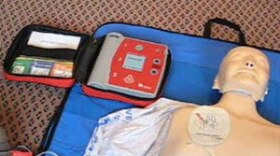When a patient’s heart stops, responding quickly is a matter of life or death. A new study out of UT Southwestern shows some hospitals respond faster than others — with a life-saving medication.
If you’ve ever seen someone have a heart attack in a TV show or in the movies, you know the drill: crash cart rolls out, conducting gel goes on chest, paddles get charged and …ZAPPP! An electrical shock gets the heart pumping again.
Well, Dr. Rohan Khera says shocking the heart works only about 25 percent of the time.
“If a heart has a bad rhythm that quivers, that’s something you can shock out of,” Khera says. “But if the first rhythm is not something that if the heart is quivering, that’s the time you give epinephrine or some other medications at that point.”
Khera, a Cardiology Division fellow at UT Southwestern says you might not see it in prime time, but the bulk of cardiac arrests are non-shockable, meaning a defibrillator alone won’t work. So, along with CPR, pumping epinephrine, also known as adrenaline, through an IV is standard practice. What isn’t standard is how long it takes hospitals to give patients epinephrine, and how many of them survive.
“We see a lot of differences across hospitals on how many patients survive to discharge if they have a [cardiac] arrest in the hospital,” he says. “And there is some data out there to suggest that incremental delays in giving epinephrine — in terms of every added minute — reduces survival time.”

Khera’s observational study, published online in the journal Circulation, reviewed more than 100,000 records of patients whose hearts stopped while at hospitals across the country. He found considerable variability in how quickly epinephrine was administered. At the hospitals where it was given quickly, patients had a 20 percent higher survival rate.
“Although guidelines recommend giving epinephrine as early as possible, hospitals are not conforming to that guideline,” Khera says.
What could cause delays? Khera says it’s probably an operational challenge.
“Cardiac arrest is one of those fields where team mechanics play a very important role, and part of our study is that hospitals that have high volumes actually do better,” he says.
In other words, it plays on experience.
Khera says since his study was observational, he’d like to identify the poor-performing hospitals, train staff to shorten epinephrine delivery time and track the results to see if that really does improve outcomes for patients. The result, he says, could be big.
“You would find a lot more people are more likely to survive to discharge and among people who survive to discharge a lot more people are likely to have good functional status.”





